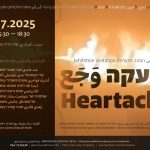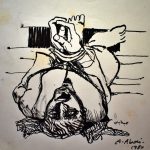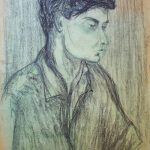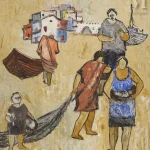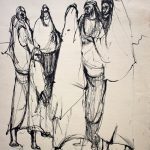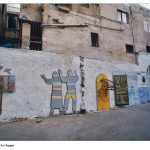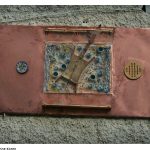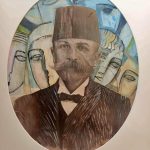
Palestinian artists of the second half of the twentieth century, when interviewed, sometimes speak of being the first to do this or that, or that theirs was the first Palestinian one-artist exhibition, etc. The trauma of the Nakba caused an absence in knowledge. Closer study reveals that, despite this perceived chasm in the continuity of Palestinian painting and sculpture, there were precious connections between the two halves of the twentieth century in Palestinian art history that were so traumatically divided.
The fragile connections between the two halves, between the older generation and those coming to maturity after the Nakba, held unusual importance. For example, the mentorship between teacher Daoud Zalatimo and his student Ismail Shammout expanded in significance due to the agonies of forced dispossession. It was news among Palestinian artists when in 1995, forty-seven years after their separation amidst the Nakba, Shammout traveled to Jerusalem to visit Zalatimo, who was near death. Another of many examples is the connection between the painter and muralist Khalil Halabi and his student Kamal Boullata, which actually took place in Jerusalem between the Nakba and the 1967 expulsions. Also to be noted is the special trip to Nazareth that artist Vera Tamari of the new generation made in 1985 to meet with the old ceramist and sculptor Hanna Musmar, helping thereby to alleviate the divide created by the occupation between the artists of the West Bank and those living directly under the Israeli entity.
Although a certain pall fell over the Palestinian art world in the wake of the 1948 Nakba, there remained a surprising number of professional artists practicing on Palestinian soil during the 1950s and early 60s. They, along with a host of amateurs, kept traditions alive. Jamal Badran and his brothers Khairy and Abdel Razzak, Sophia Halaby, Mubarak Sa’ad, and Daoud Zalatimo lived and continued to practice in Jerusalem, as did the lesser-known Nahile Bishara. Hanna Musmar worked in Nazareth and Butros Lucia worked in Shafa Amer and the Galilee. The calligrapher Yousef Najjar worked in Bethlehem, while Muhammad Siam worked in Jerusalem. There were also a few foreign born artists who had taken Palestine as their permanent home. They are part of the story of Palestinian painting. One was George Aleeff, who had voluntarily come to Palestine from Russia to escape the working class revolution of 1917 only to be made a refugee by the other side of the class divide, the Zionists.
These quiet decades, however, contained the seeds of a powerful new movement. A new generation of artists was busy learning. In 1953 Ismail Shammout, still a student, mounted a show in Gaza with a few other artists that would prove to be a momentous event. The exhibition was titled “Where To?” and consisted of paintings of the mass expulsion of refugees from Lidd, which came to be known as the march in the wilderness. All of Gaza and its refugees came to see it. This stunning response was a hint of the bottled up hope for liberation. The Gaza exhibition marked the very beginning of the liberation movement in its artistic form and was followed by a flood of individual and group shows by a new generation of artists a decade later. [1]
There were two epicenters of the liberation art movement; one was strong during the 1970s in Beirut while the other was gaining momentum in the West Bank and Gaza. Palestinian artists, regardless of where they settled after the Nakba, embraced the new aesthetics of this movement and joined the exhibitions organized by its activist artists. But the most difficult place for Palestinian artists to participate in this movement was within the borders of the major portions of Palestine that were lost in 1948 (Palestine48) and occupied by the Israeli entity.
The most instrumental in helping to motivate the movement in Palestine48 was the artist Abed Abdi. Abdi had the good fortune to be part of the Communist Party (CP); as the artist Abdul Tamam of Kafr Qasem so succinctly put it Abdi “was protected by the Communist Party and was able to function in those days of severe oppression.”[2] Yet, the other side of this coin was that this involvement, as well as his association with leftist Israeli artists, brought him criticism.
Abed Abdi was born in Palestine in the northern city of Haifa in 1942. He was six years old when the violence of the 1948 Nakba divided his family. While his father remained in Haifa, Abdi’s mother wandered with him and his siblings from refugee camp to refugee camp in Lebanon and Syria. Life in refugee camps just after 1948 was extremely painful. After three years of separation and displacement they were able to return to Haifa. By then Abdi was nine years old:
Maybe four years after my return [to Haifa], I realized that I had a tendency towards art resulting from troubles. I did not live a happy childhood…The socially and politically restricted environment led me to question why things were as they were, why was my sister in exile, why are there wars, why are there closed borders and as a result I realized that I needed creativity, a spiritual need, and it was perhaps a language of expression available to me.[3]
In 1962, when he was twenty years old, Abdi had his first one-artist show in Tel Aviv at a club, he said, of progressive and leftist Israeli Jews. It was the first show made by a Palestinian of the Dakhel [Palestine48].[4] As a consequence of his affiliation with the Communist Youth Alliance, Abedi made a strong association with this specific community from a very early point in his artistic career.
Having been active with the Communist Youth Alliance in Haifa, Abdi was sent by the CP in 1964 to study at the Dresden Academy of Fine Arts in the German Democratic Republic. He stayed until 1971, studying mural painting, graphic design, and sculpture.[5] While in Dresden, he became a protégé of Lea Grundig, herself a student of modernist painter and printmaker (and staunch dissident) Otto Dix: “I was accepted as a special student by Lea Grundig and studied with her for two years. I built a good relationship with her. She belonged to a German Jewish family and had fought against Nazism.”[6] Through Lea Grundig he came under the indirect influence of her husband’s work, painter Hans Grundig, as well as the Blaue Reiter and Die Brücke movements. Both Lea and Hans Grundig were lifelong members of the German Communist Party, although Hans had passed away before Abdi’s arrival. While in the German Democratic Republic, Abdi also became familiar with and influenced by the work of Käthe Kollwitz whose class-conscious sculptures, paintings, and prints document the plight of the oppressed.
Surviving in Galilee for artists during the first decades after the Nakba was nearly impossible. Palestinians under Israeli rule were poor and work was scarce. Abdi, although fortunate in his association with the CP, was aware of the plight of other artists:
Clearly my situation was difficult but it was easier than I had imagined. In those early years, attention to art began to happen. Here and there, clubs and popular seminars appeared, and I began to organize informal teaching courses. I returned [from Dresden] in 1971 and by 1972 I was employed in Al Ittihad and Al Jadid [organs of the CP] as a designer and writer in the area of art and art history. This job helped me a great deal. I could take my artistic message to the people who were thirsty for art. The village of Kufr Yaseef is where I did the first course beginning in 1975 and I continued to do the weekly course till the year 2000. For twenty-five years, I traveled in buses and other methods from Haifa to Kufr Yasif to do this. [7]
Artist Zahed Harash remembers attending several night sessions during the1970s when Abdi would come to a village twenty kilometers outside of Haifa [Kafr Yasif] to teach in the evenings. It was a rare and heroic effort on the part of students and teacher, as there was no public transportation available after dusk. Harash relates that he often waited to the end in order to drive Abdi back to Haifa where he had still to complete his duties at Al Ittihad. [8]
During the first decades of his artistic life, Abdi executed and published an extensive set of graphic works. While still a student in Dresden, he created a series of graphic works about Palestinian villages, land confiscation, and refugees that was published in 1973. Then in 1977, Abdi illustrated the first Arabic edition of Emile Habibi’s seminal book The Secret Life of Saeed: The Pessoptimist. [9] The distinguished writer was also a member of the CP and thus a comrade of the artist. Between 1980 and 1982, Abdi illustrated a series of short stories by Salman Natour of the general title Wa Ma Nasaina (and we did not forget), which were published in Al Jadid. [10] He continued working in black and white illustration throughout his early career, publishing continuously in Al-Ittihad and Al-Jaddid. In 1993, he posthumously published and illustrated a book of his brother’s short stories and writing—all of which had been first published in Al-Ittihad.
[Abed Abdi, “Massacre at Lidd” (1981) from the series Wa Ma Nasaina’. Image copyright the artist.]
[Abed Abdi, “Prisoners” (1981). Image copyright the artist.]
The massacre of six Palestinian demonstrators on 30 March 1976 was not unusual if one considers the many brutal massacres and executions the Israeli entity committed and continues to commit against the Palestinian population. Yet this specific event became the subject matter of an important sculpture as well as the rallying point for the annually commemorated Palestine Day of the Land. The timeline of the massacre began when the Israelis announced the expropriation of over 5,000 acres of agricultural land. It was the time of the first Intifada, a time of high revolutionary spirit. Thus when the CP and Palestinian organizations called for protests, the population responded enthusiastically. During the demonstrations, in addition to the six protesters who were killed, over 100 were wounded and a massive number arrested. The event echoed among Palestinian activists worldwide.
In concert with the high spirits of the time, Abed Abdi, in partnership with his CP comrade Israeli artist Gershon Knispel, completed a monument to be erected in the heart of Sachnine, the village where most of the demonstrations had taken place. Since this was not allowed by Israel, the monument was erected, in 1978, in the town’s graveyard. It is sculpted in the form of a sarcophagus as a tomb for the six martyrs. The commemoration of this event as the Palestine Day of the Land is marked internationally; and in Galilee it takes place at the graveyard around the memorial. The monument is the most important work of sculpture done in Palestine during the twentieth century, and is five by fifteen by ten feet. The four sides of the monumental sarcophagus are covered with aluminum bas-relief and the whole is raised approximately four feet above the ground on a concrete base. It is visually muscular, betraying the enthusiasm of the artists. It possesses the same Cubist overtones as Soviet public sculpture and tells of Abdi and Knispels’ individual sympathies, of their optimism, and of their love for the revolutionary abstraction of the early twentieth century.
[Abed Abdi and Gershon Knispel, “Nasb al-Tizkari” memorial for the six martyrs of the Day of the Land (1978). Image copyright Samia Halaby.
In 1979, Abdi and Knispel organized an exhibition in Tel-Aviv titled Israeli And Arab Artists Exhibiting Together. When asked about the event, Abdi recalls, “It was held at the galleries of the Union of Israeli artists of which I was a permanent member.” [11] Many Palestinian artists from the West Bank joined the show. The purpose of the exhibition was to show unity against the Israeli detainment of West Bank artists and the closure of Gallery77 in Ramallah, as well as the confiscation of artwork from Gallery77 and elsewhere. It was during this time that artist Fathi Ghaban was imprisoned and his paintings seized by the Israeli military administration because of its subject matter and colors in support of the Intifada. Abdi, Knispel, and several other leftist Israeli artists went to Gaza to demonstrate their solidarity with Ghaban and to demand his release.
[Abed Abdi, “Intifada” (1986). Image copyright the artist.]
Abed Abdi is a prolific artist, having produced a significant body of work that remains largely undocumented. During the first stage of his artistic career, he primarily worked in color and black and white. The painting “Intifada” (1986) exemplifies his formal skill while also revealing that sympathies across Israel’s artificial borders and checkpoints remain strong. “Intifada,” in its subject matter and approach, is an image that was more common in the West Bank and Gaza than in Palestine48. Another painting, “Siege of Beirut” (1982), reveals that solidarity also transcended international borders. The painting is contemporaneous with a poignant real-life story of a boy in a refugee camp who, having lived with the emotional trauma of his elder’s dreams of Palestine, constructed wings and actually glided through the air, landing in a kibbutz where he was killed. In form, “Siege of Beirut” has the powerful geometric and graphic-art aesthetic of early Constructivist artists of the 1917 Soviet revolution, painters such as Olga Rosanova and Liubov Popova.
[Abed Abdi, “Siege of Beirut” (1982). Image copyright the artist.]
In 1984, Abdi organized an exhibition in Nazareth to commemorate the twentieth anniversary of the Palestine Liberation Organization. The show was titled Towards the Creation of a Radical Palestinian Arab Art. An exhibition with such intentions and such a title was a brave undertaking when one considers that during the decade of the 1980s, the period of the first Intifada, Israeli authorities were known to vandalize Palestinian exhibitions, confiscate artwork, and imprison artists. Not every artist is prepared to face such consequences.[12] Less risky was to join the Palestinian Arab section within the Union of Israeli artists, which he also did. Through involvement with this union, he intended to help mitigate the deep isolation of the Palestinian artist. Many took his lead and joined the organization, including artist Khalil Rayan who, with many others, in due time found the atmosphere exclusivist and disrespectful to Palestinians and thus withdrew. [13]
In the mid 1990s, Abdi organized and led a union of artists in Palestine48. Reflecting on that time, he contends that as the artistic scene among Palestinians matured, he was able to see many of his students in leading roles. He also observes that in Palestine48 from 1948 until 1972, there were only three artists who had formally studied art and that by 2012 there were 280. In this and in all that we learn of the artist, it is clear that the intensity of oppression has created a stubbornness to endure, to persist, and to grow. It is not unlike the survivors of the Kafr Qasem massacre of 1956 who defiantly point out that even though only twenty-three out of the forty-nine workers who were murdered by the Israeli Border Police left behind children, that by 2011 those orphaned children had themselves produced 2,701 children and grandchildren. [14]
During his mature years, Abdi’s work evolved towards greater abstraction; political comments are no longer explicit. At the Sakakini Cultural Center in Ramallah in 1997, he exhibited a series of constructions utilizing windows to express a host of themes related to Palestine and the greater Arab world. That which is inside, hidden, forbidden, and maybe imprisoned, confronts the freedom of those outside curiously attempting to look in. The dialogue that arises from this interaction with the work could signify a political one between Palestinians of Al Dakhel [Palestine 48] with exiles outside. The series also incorporates flirtation between men and women, as for example in “Yousef, I Am Georgette.” The title alludes to lovers modestly separated by a window, as in Spanish and Arab traditions. Concealed inside, Georgette identifies herself to Yousef. Other titles, such as “The Hidden and the Exposed and Barricaded Window,” show Abdi using complex layers of significance. “The Hidden and The Exposed” evokes the damaged and barricaded homes of Palestinians to which rightful owners are prohibited from returning.
[Abed Abdi, “Majnoune” (2012). Image copyright the artist.]
Today, Abed Abdi lives in Haifa and continues to work as both an artist and educator. He produces abstract work, alongside that which references Palestine in a symbolist manner. One example is an assemblage of objects that are arranged within a drawer titled, “Majnoune.” The drawer functions as a container for the symbolic. He recounts finding similar drawers still full of the mementoes people tend to collect in them in garbage piles. ”Majnoune” also takes its inspiration from Emile Habibi’s short story character Um al-Rababeek, a woman who lost her husband during the 1948 war and remained alone in the Wadi al Nisnas section of Haifa. The neighborhood had originally housed 1,000 people but become a concentration camp of 5,000 residents who were driven out of their homes in other areas. When Um al-Rababeek went mad out of grief for her beloved husband, she began to collect rubbish. “Her story,” Abdi recalls,” reminded me of my father, Qasem al-Abdi, who remained in Haifa when his whole family left. He returned to his home in Wadi al-Salib and wanted to see what was left there. He only found the birth certificates of his family, all else had been stolen.”[15]
[1] Ismail Shammout, Fan Tashkil Fi Filestine (the Visual Arts in Palestine), 1989. Qabas Printers: Kuwait. Shammout lists over 150 exhibitions, and states that many small exhibitions took place in schools and refuge camps throughout Palestine that are not accounted for.
[2] Interview with the artist. October 30, 2012
[3] Ibid.
[4] Ibid.
[5] Abed Abdi: 50 Years of Creativity, edited by Tal Ben Zvi, Um el-Fahem Gallery: 2010 (page 222).
[6] Interview with the artist. October 30, 2012
[7] Ibid.
[8] Zahed Harash, updated newspaper article in Arabic “The First Teacher,” in addition to an interview with the artist September 30, 2011.
[9] Abed Abdi: 50 Years of Creativity (page 212).
[10] Abed Abdi: 50 Years of Creativity (page 211).
[11] Interiew with the artist, October 30, 2012.
[12] Interview with the artist, January 2, 2000. Abdi wrote about the exhibition citing the participation of Jamal Bayari from Yafa, Ibrahime Ibrahime from Rina, Abed Younis, and Thaer Zaydan.
[13] Interview with Khalil Rayan, 1999.
[14] Al-Shorok, October 2011, issue n. 240, 24th year, page 10. (Al-Shorok is the local magazine of Kafr Qasem, which is published by Majd Sarsour.
[15] Interview with the artist, October 30, 2012.
By Samia Halabi
published in:

